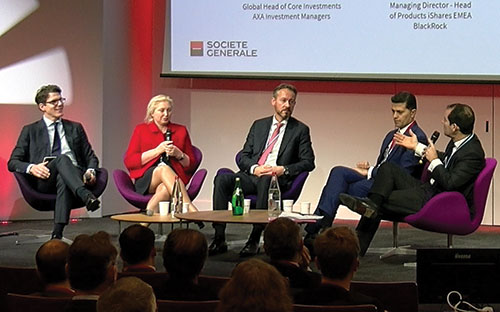The comparative merits of these two methods of investing prompted lively debate at SGSS’s investor conference in Paris.
As the proportion of assets in passive funds increases year on year and as actively managed, stock-picking funds continue to haemorrhage cash, the two contrasting investment methods came under close scrutiny at a conference last month.
A high-level panel at the SGSS European Investor Summit discussed, among other things, how to restore investor confidence in the active sector – with some questioning whether the two styles are mutually exclusive and whether it isn’t possible instead to benefit from the best of both worlds.
Also discussed was whether passive strategies, artificial intelligence and ESG could be the salvation of the asset management industry.
Nicolas Gaussel, chief executive of Metori Capital Management, set the scene for the debate by saying that when people talk about active management, they are generally referring to what is known as “active core”, meaning the stock-picking of large stock equities.
“It’s true that if you look at recent figures from the Boston Consulting Group, the global assets under management (AuM) of the active core in terms of the percentage of the industry has shrunk from 46% after the global financial crisis to 33% now and there has also been a decrease of market share of the global active core,” he said.
Meanwhile AuM in the passive industry has, during the same time, risen from $4 trillion (€3.6 trillion) to $14 trillion, capturing almost 20% of the market share of the total asset management industry.
Gaussel, who is also Metori’s co-chief investment officer, asked whether this change was enough to conclude that passive is ‘eating’ active. “It’s not that straightforward, because if you look at the other categories, they are extremely active,” he said.
“You have the alternatives, which obviously are very active, the so-called active specialties, the real estate and the non-liquid [strategies], and the so-called solutions
and liability-driven investment products, and all those categories are very active.”
Semantics
Benoît Sorel, head of iShares for Emea at BlackRock, said that in the debate about passive and active investment styles, an important semantics distinction – namely that all investment decisions are fundamentally active in nature – is often overlooked.
“The first choice you make when you take an active investment decision is, which asset allocation do you implement?” he added. “Do you invest in bonds? Do you invest in equities? If you invest in bonds, is it investment grade? High yield? All of these are active decisions.
“Secondly, if you dig deeper on European equities, do you invest in Euro Stoxx 50 or MSCI Europe?
“All of these decisions are active decisions, although they are index decisions. Any portfolio perfomance attribution says that 90% of performance comes from the asset allocation, index and static factor exposures.”
Asked how this affected a fund house focused on multi-asset, Fabio Melisso, chief executive of Fineco Asset Management, said that in the present economic climate, it was too risky to only invest passively.
“Currently, we use active and passive strategies together as they complement each other. However, the right mix is also affected by the specific phase of the economic cycle.
“At present, we prefer maintaining the highest level of quality in our portfolio construction by having an increased exposure to active than passive strategies. Probably in a different economic phase of the cycle, further down the line, the mix could be different with increased exposure to passive, but not yet,” he added.
Hans Stoter, global head of core investments at Axa Investment Managers, said that passive investments “can be an interesting building block for a multi-asset strategy”.
“I fully agree that any investment decision is an active investment decision, so the decision to buy US equities today is highly active, to do that in the S&P 500 is an active decision and implied in that is that you want to have an index-like return,” he said.
Stoter added that when the focus is on an index, the return (minus low fees) versus a benchmark plus alpha return (minus higher fees) are just two of the possible outcomes.
“Especially in the current low-yield environment, I think outcome-oriented strategies – that is total return strategies not linked to any market index, completely index-agnostic, but focused on an attractive total return with a lot of emphasis on downside protection – are very important.”
Fiona Frick, chief executive of Unigestion Group, said that the experience of her firm is that different factors – such as minimum variance, quality, growth, small cap – over time and in different regions “perform well and explain part of the active performance that was attributed to active managers”.
The only caveat, she said, is that the definitions of a value stock, a value index, a value portfolio or a minimum variance portfolio are all subject to interpretation “and there are as many interpretations as there are asset managers and as many interpretations as there are indices”.
©2019 funds europe





